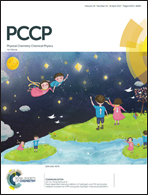Hydration-controlled anisotropic and giant permittivity in TEG-functionalized eumelanin†
Abstract
Although it has long been known that the peculiar electronic–ionic conductor behavior of eumelanin is critically dependent on hydration, the detailed mechanisms by which water–polymer interactions control and affect the conduction properties have remained largely obscure. In this paper, we report a remarkable anisotropy and giant polarization effect in a synthetic eumelanin (TEGMe) chemically functionalized with hydrophilic TEG residues. FT-IR analyses of water sorption isotherms and AC measurements were consistent with a microporous structure binding or hosting mainly isolated water molecules. In contrast, similar experiments on a commercial synthetic eumelanin (AMe) used as a reference were suggestive of a bulk macroporous scaffold binding or hosting liquid water. These data disclosed for the first time the differential impact on eumelanin conductivity of vapor, liquid and ice-like forms of water adsorbed onto or embedded into the polymer layer. It is thus demonstrated, for the first time, that hydration controls the conduction properties of eumelanin in a more complex manner than is commonly believed, involving, besides the reported semiquinone comproportionation equilibria, the mode of interaction of water molecules as governed by both the chemical and morphological features of the polymer.



 Please wait while we load your content...
Please wait while we load your content...